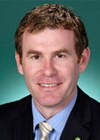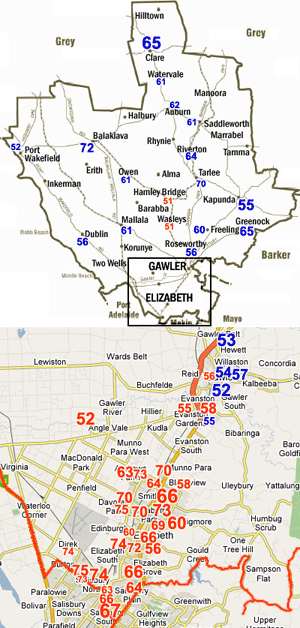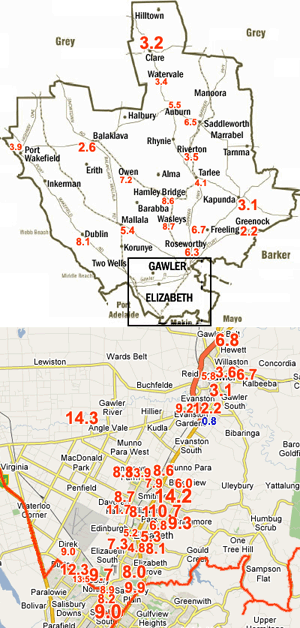Electoral Form Guide: Wakefield
Electorate: Wakefield
Margin: Labor 6.6%
Location: Outer Northern Adelaide, South Australia
In a nutshell: Once a conservative rural seat, Wakefield was sucked into some of the most strongly Labor parts of Adelaide when the seat of Bonython was abolished in 2004. The Liberals did well to narrowly hold the seat in 2004, but Labor’s Nick Champion easily overcame the slender Liberal margin in 2007.
The candidates
|
|
|
Two-party vote map
|
Swing % map |
Electorate analysis: Extending from northern Adelaide deep into rural territory beyond, the highly diverse electorate of Wakefield was one of three in South Australia which fell to Labor in 2007, along with Kingston and Makin in the south and east of the city. The electorate has existed since South Australia was first divided into electorates in 1903, but was changed almost beyond recognition when the state’s representation was cut from 12 seats to 11 in 2004. It now covers the outer northern Adelaide industrial centre of Elizabeth (formerly the basis of abolished Bonython), the satellite town of Gawler, the Clare Valley wine-growing district and a stretch of Gulf St Vincent coast from Two Wells north to Port Wakefield. Elizabeth marks the first incursion into Adelaide of a seat that traditionally covered the Murray Valley and the Yorke Peninsula, which were respectively transferred to Barker and Grey. Labor’s overwhelming strength in Elizabeth is balanced by strong support for the Liberals in Clare and the rural areas, along with a less pronounced leaning to the Liberals in Gawler.
Wakefield had only previously been won by Labor in 1938 and 1943, and by the Country Party in 1928. It was otherwise held by the prevailing conservative party of the time, be it the early Liberal Party, the Nationalists, the United Australia Party or the modern Liberal Party. Neil Andrew became member in 1983, serving as Speaker from 1998 until his seat was effectively pulled from under him by the addition of low-income Elizabeth, which turned a 14.7 per cent Liberal margin into a 1.5 per cent notional Labor margin. After considering the obvious option of challenging Patrick Secker for preselection in Barker, Andrew instead chose not to contest the election. Wakefield was nonetheless retained for the Liberals at the ensuing election by David Fawcett, who picked up a 2.2 per cent swing against Martyn Evans, Labor’s member for abolished Bonython. This was driven by a Labor slump in Elizabeth which outweighed small positive swings in more affluent rural areas, delivering a narrow 1010-vote victory to Fawcett. The trend was reversed by a 10 per cent swing to Labor in Elizabeth in 2007, consistent with a national trend in low-income urban areas.
The incoming Labor member was former state party president Nick Champion, a one-time employee of the Shop Distributive and Allied Employees Association and later staffer for state Industrial Relations Minister Michael Wright. The Liberals have nominated David Strauss, a Gawler councillor. David Fawcett meanwhile is set to return to politics after securing the number two position on the South Australian Senate ticket.
Analysis written by William Bowe. Read Bowe’s blog, The Poll Bludger.





